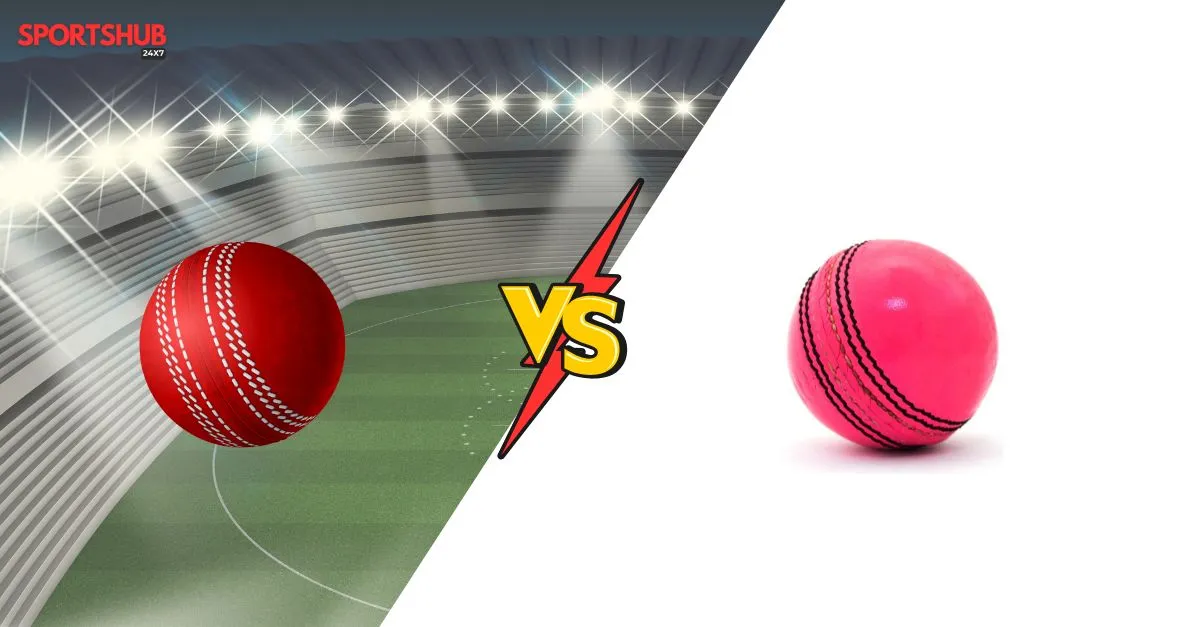Are you hooked on the Ind Vs Aus 2nd BGT Test Match? Do you want to know the difference between Pink ball and Red Ball test matches? If you answered yes, then this post can help you differentiate between both colored balls used in test cricket.
Australia and New Zealand played their first pink ball Test match in 2015. Players haven’t completely adjusted to the once-in-a-year event, though, because there haven’t been many Test versions in home and international cricket since then.
Since it’s time for another interesting test, both experts and fans are trying to understand how the both the balls differs and how the players can adapt to it. The pink ball turns out to be more than just the typical red cherry’s showier sister. It is indeed a cousin who enjoys the nightlife. So, let’s check out Pink ball Vs Red Ball Major Insights.
How Pink Ball Is Different From Red Ball?
Pink ball color was introduced in 2014 to start the day-night matches and ensure the visibility of the ball under the night light. When Orange, Pink, and Yellow balls were tried, ultimately Pink color captured the attention of everyone as it is very much visible in the artificial light as well. This ball is layered with polyurethane while the traditional red ball is dyed.
The major difference between these two balls is their seam color. For Pink balls, this major change was made in 2016, when black seam color was introduced to make the difference in visibility criteria. The lacquer layer present on the top layer of this ball helps increase swing, especially under the night light. This additional layer helps maintain the durability and shine of the ball and creates difficulties for the opponent team.
How Does The Pink Ball Affect The Test Match?

To understand that, the most important thing to care about is a cricket ball swings because of the friction caused by air on both sides of the ball. This is the reason why it is asked to maintain the condition of the ball till the end. Pink ball moves laterally in the air for the longer duration of time in comparison to red ball due to the extra layer of shine added to it.
In addition, there is less pace loss after throwing because of the extra lacquer, which makes the pink ball skid more (smoother surface, less friction). Due to this, a noticeable variation in pace can be used by both pacers and spinners to trick the batters. The reaction times of a batsman to specific bowlers and delivery types are conditioned by their experience playing the red ball. The batters’ major adjustment comes when they have to decrease their reaction time because the pink ball is skidding a lot more.
Playing Conditions For Day & Night Tests
The International Cricket Council (ICC)approved day-night test matches in 2012, which was a significant departure from the traditional format of test cricket. This creative action attracted more viewers and infuse a new life to test cricket. The first ever day-night Test Match was played between Australia and New Zealand in 2015 at Adelaide Cricket Ground, Australia.
A pink ball is used in place of the typical red ball, which is the actual way that a day-night test differs from a standard test. Making this adjustment is essential for improving sight in artificial illumination. The customary tea break is kept in place to enable the day-night schedule, and a dinner break is substituted for the lunch break. The best possible playing conditions and spectator experience are guaranteed by this modification.
Read More: How India Can Qualify For WTC Final 2025
Conclusion
The design, visibility, and performance under specific conditions are the main distinctions between the red and pink cricket balls. The lacquered coating on the pink ball, which was first used for day-night Test matches, improves durability and visibility in floodlights. It helps bowlers since it has a firmer seam and swings more in humid situations. The classic red ball, on the other hand, performs consistently and requires less lacquer, making it more appropriate for daytime games. One of the difficulties facing the pink ball is preserving its color and sheen, which affects how it behaves over time. These differences provide cricket more strategic depth by making each ball appropriate for particular formats and conditions.
FAQ
Q. What is the difference between red ball test and pink ball test?
A. Pink ball has an additional layer of lacquer that helps the ball to last long in long format match.
Q. Does pink ball swing more than red ball?
A. Pink cricket balls continue to swing and bounce well after 40 overs, while red cricket balls have a high swing and bounce for the first 15 overs. This is because of the Pink Ball’s PU coating, which keeps it looking very new for a long time because it doesn’t easily peel off.
Q. Why is white ball used in ODI?
A. Since white balls are more visible at night, they were introduced when one-day matches started to be played under floodlights. Today, white balls are used in all professional one-day matches, even those that are not played at night.
Q. Why is pink ball test difficult?
A. The additional lacquer may make the ball swing more, particularly in low light, and it may act differently than red or white balls. Additionally, some spinners may find the lacquered surface more difficult to hold.
Q. Who is the highest run scorer in pink ball test?
A. With 894 runs at an average of 63.85 throughout eight games, Marnus Labuschagne is in first place.
